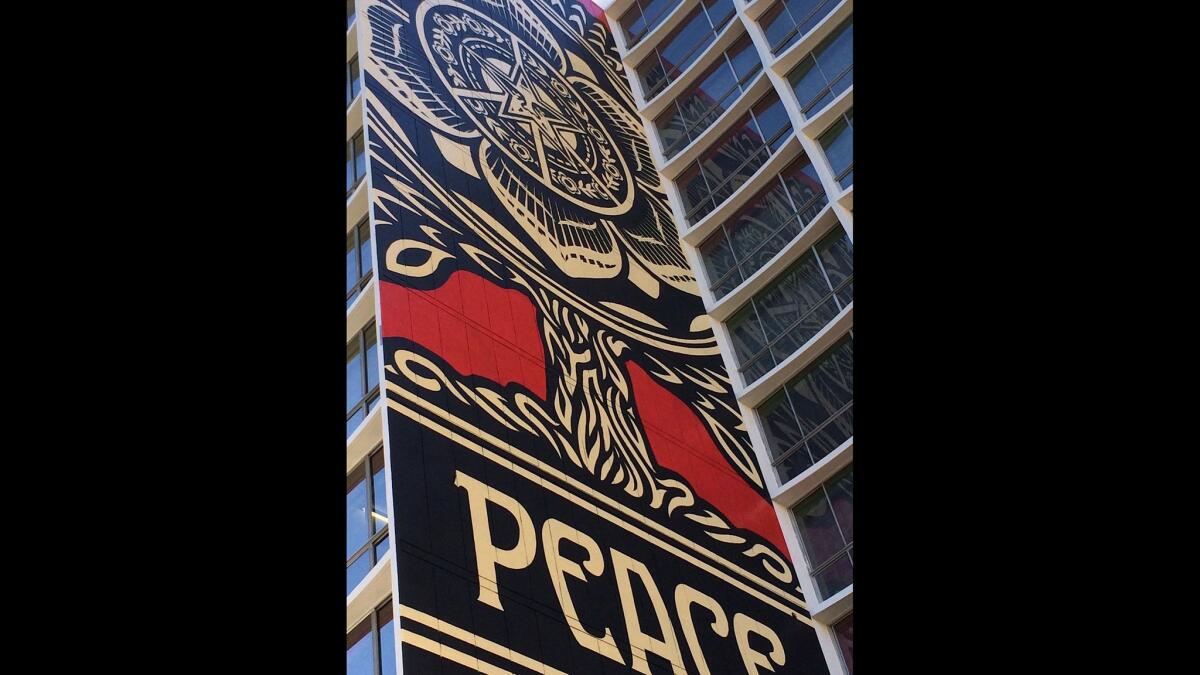In the era of Instagram, businesses use street art to attract customers
- Share via
Inside the shops along Melrose Avenue, there’s plenty to appeal to fashionable young customers such as Melissa Wang. But it was outside the Paul Smith store where the 25-year-old found what she was looking for.
“Did you even visit L.A. if you didn’t stop to take a photo in front of the pink wall?” said Wang as she snapped a photo of her friend.
From morning until night, a steady stream of visitors from across the city and around the world pose, pout and preen in front of the clothing store’s Pepto Bismol-hued wall. The crowds are so intense that the store hired a security guard to keep things under control.
Street art is ingrained into Los Angeles’ DNA — the city’s sprawling concrete backdrop has long served as a massive easel for artists, from the muralists who pioneered the vibrant Chicano art movement to the graffiti writers plying their trade along the L.A. River. But in the age of social media, street art is finding a new role: providing the perfect backdrop for Instagram-worthy shots, and the perfect lure for retailers seeking to attract a certain selfie-taking demographic.
With millennials willing to go out of their way to find a piece of Instagram gold, businesses are eyeing the artwork as a tactic to draw people outside — and then, hopefully, inside — their stores. No longer relegated to alleyways or roll gates, street art now coats the facades of yoga and spin studios, restaurants, bars and retail boutiques.
At the Line Hotel in Koreatown, the “Peace Tree” mural by Shepard Fairey brings passersby in from the street, said Gabriel Ratner, vice president of operations at Sydell Group, which owns the hotel.
“People stop by to grab a photo and then end up coming into the hotel lobby for a cup of coffee or cocktail,” Ratner said.

The hotel commissioned Fairey, famous for designing the Barack Obama “Hope” poster, to design the massive 10-story artwork for exactly that reason.
“It’s for everyone in the neighborhood to enjoy and take Instagram photos,” he said.
A dazzling blend of melting rainbows by artist Jen Stark has turned the parking garage at Platform, an outdoor mall of independent artists and merchants, into an unlikely attraction.
“We wanted to take an Instagram photo,” said Alisha Brown, a first-time visitor to the Culver City shopping center. “Now, we got a cup of coffee and we’re going to do some shopping.”
The intersection of business and street art hasn’t always been so rosy. The medium shares a tumultuous history with Los Angeles.
In 2002, as advertisers forked over money to turn brick walls into billboards, the city controversially banned murals on private property to crack down on commercial advertising disguised as street art. After debate and public backlash, the City Council lifted the ban in 2013, but only under the strict condition that no murals could contain commercial messages.
Since the ban was lifted, the Department of Cultural Affairs has declined 38 of 123 mural applications, some of which were attempting to create commercial signs with corporate logos, Public Art Division Director Felicia Filer said.
There’s an irony in partnerships between street artists and businesses. As an offshoot of graffiti — a countercultural art scene long the bane of property owners — street art and retail businesses would seem to be natural enemies. It has left some artists facing a moral dilemma: stay true to the guerrilla traditions of their artform or forge partnerships that can exponentially increase the amount eyes on their work and the dollars in their pocket.
This question vexed artist Colette Miller, who is responsible for one of Instagram’s best-known backdrops.
After illegally painting a pair of angel wings in the Arts District in 2012, Miller found popularity almost immediately. Instagrammers flocked to the scene, and local businesses started approaching her about putting a pair on their walls.
After meditating on the dilemma, she concluded it was better to get her art into materialistic spaces and provide people an opportunity to think about what’s really important.
“I know people are trying to make money off my art, but the goal of the wings is to remind people that we are angels of the Earth,” Miller said. “Whether it’s in a mall, prison or hospital, it doesn’t matter. We’re divine souls wherever we are, so why be snobby?”
Since then, her Global Angel Wings Project has taken off, with more than 200 sets of wings across the world. Miller said about 90% of her work is commissioned. The rest goes to areas of unrest, such as Juarez, Mexico, to provide a symbol of peace.
“I’d rather work with permission and be sanctioned,” Miller said. “With rogue graffiti artists, there’s a level of disrespect and arrogance that their art can live on a building they don’t own because their message is so great.”
Miller, however, refuses to compromise on one aspect: corporate branding.
When Angel City Brewery commissioned her to paint a set of wings, she obliged. When she returned to find that the company had put its own branding on the mural, she immediately asked that the added branding be taken down. (Angel City said it removed the branding, apologized to Miller and reprimanded an employee responsible).
“This isn’t an advertisement, it’s an experience,” Miller said.
For businesses, writing a check to a respected artist can be a substantial expenditure. According to Fixr, the average commission on a 20-foot by 10-foot mural is $8,020. Depending on the intricacy of the piece and the size of the wall, that number can grow up to $20,000.
Rather than pay out, some businesses are finding alternative ways to woo the Instagram scene.
Four years ago, the furniture company Cisco Home tapped its in-house marketing team, Small Green Door, to draw a mural that said “Made in LA.” Hailing it as LA’s latest Instagram-ready landmark, Cisco offered discounts to anyone who snapped a photo with the mural and posted it to Facebook using the hashtag #MadeInLAbyCisco.
Multiple L.A. locations of Zero Degrees, an ice cream and bubble tea chain, display a set of wings similar to Miller’s work — and the knockoff strategy appears to be working.
Patrons regularly plaster the shop’s Yelp page with photos of themselves in front of the piece. “Zero Degrees gave me wings,” wrote one customer.
To read the article in Spanish, click here
[email protected] | Twitter: @rachelspacek
[email protected] | Twitter: @jflem94
ALSO
#WomenBoycottTwitter to show support for those harassed on the social media platform
Instapoet Rupi Kaur may be controversial, but fans and book sales are on her side
Did your Tamagotchi die of neglect in the late ‘90s? Now’s your chance to take another shot
Facebook looks to lower-cost virtual reality with $199 Oculus Go headset
UPDATES:
7 p.m: This article was updated to include a response from Angel City Brewing.
This article was originally published at 5 a.m.
More to Read
Inside the business of entertainment
The Wide Shot brings you news, analysis and insights on everything from streaming wars to production — and what it all means for the future.
You may occasionally receive promotional content from the Los Angeles Times.











